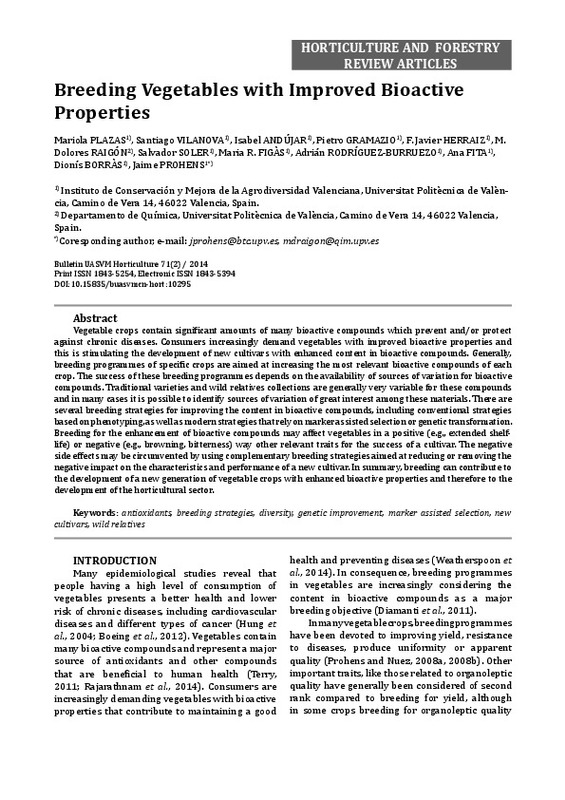Plazas Ávila, MDLO.; Vilanova Navarro, S.; Andújar, I.; Gramazio, P.; Herraiz García, FJ.; Raigón Jiménez, MD.; Soler Aleixandre, S.... (2014). Breeding Vegetables with Improved Bioactive Properties. Bulletin of University of Agricultural Sciences and Veterinary Medicine Cluj-Napoca : Horticulture. 71(2):165-172. https://doi.org/10.15835/buasvmcn-hort:10295
Por favor, use este identificador para citar o enlazar este ítem: http://hdl.handle.net/10251/62873
|
Título:
|
Breeding Vegetables with Improved Bioactive Properties
|
|
Autor:
|

 Plazas Ávila, María de la O
Plazas Ávila, María de la O

 Vilanova Navarro, Santiago
Andújar, I.
Vilanova Navarro, Santiago
Andújar, I.

 Gramazio, Pietro
Gramazio, Pietro

 Herraiz García, Francisco Javier
Herraiz García, Francisco Javier

 Raigón Jiménez, Mª Dolores
Raigón Jiménez, Mª Dolores

 Soler Aleixandre, Salvador
Soler Aleixandre, Salvador
 Figás Moreno, María del Rosario
Figás Moreno, María del Rosario

 Rodríguez Burruezo, Adrián
Rodríguez Burruezo, Adrián

 Fita, Ana
Borràs, D.
Fita, Ana
Borràs, D.

 Prohens Tomás, Jaime
Prohens Tomás, Jaime
|
|
Entidad UPV:
|
Universitat Politècnica de València. Instituto Universitario de Conservación y Mejora de la Agrodiversidad Valenciana - Institut Universitari de Conservació i Millora de l'Agrodiversitat Valenciana
Universitat Politècnica de València. Departamento de Biotecnología - Departament de Biotecnologia
Universitat Politècnica de València. Departamento de Química - Departament de Química
|
|
Fecha difusión:
|
|
|
Resumen:
|
[EN] Vegetable crops contain significant amounts of many bioactive compounds which prevent and/or protect against chronic diseases. Consumers increasingly demand vegetables with improved bioactive properties and this is ...[+]
[EN] Vegetable crops contain significant amounts of many bioactive compounds which prevent and/or protect against chronic diseases. Consumers increasingly demand vegetables with improved bioactive properties and this is stimulating the development of new cultivars with enhanced content in bioactive compounds. Generally, breeding programmes of specific crops are aimed at increasing the most relevant bioactive compounds of each crop. The success of these breeding programmes depends on the availability of sources of variation for bioactive compounds. Traditional varieties and wild relatives collections are generally very variable for these compounds and in many cases it is possible to identify sources of variation of great interest among these materials. There are several breeding strategies for improving the content in bioactive compounds, including conventional strategies based on phenotyping, as well as modern strategies that rely on marker assisted selection or genetic transformation. Breeding for the enhancement of bioactive compounds may affect vegetables in a positive (e.g., extended shelflife)or negative (e.g., browning, bitterness) way other relevant traits for the success of a cultivar. The negative side effects may be circumvented by using complementary breeding strategies aimed at reducing or removing the negative impact on the characteristics and performance of a new cultivar. In summary, breeding can contribute to the development of a new generation of vegetable crops with enhanced bioactive properties and therefore to the development of the horticultural sector.
[-]
|
|
Palabras clave:
|
Antioxidants
,
Breeding Strategies
,
Diversity
,
Genetic Improvement
,
Marker Assisted Selection
,
New Cultivars
,
Wild Relatives
|
|
Derechos de uso:
|
Reserva de todos los derechos
|
|
Fuente:
|
Bulletin of University of Agricultural Sciences and Veterinary Medicine Cluj-Napoca : Horticulture. (issn:
1843-5254
)
|
|
DOI:
|
10.15835/buasvmcn-hort:10295
|
|
Editorial:
|
University of Agricultural Sciences and Veterinary Medicine Cluj-Napoca
|
|
Versión del editor:
|
http://dx.doi.org/10.15835/buasvmcn-hort:10295
|
|
Código del Proyecto:
|
info:eu-repo/grantAgreement/MINECO//AGL2012-34213/ES/NUEVAS ESTRATEGIAS PARA LA MEJORA DE LA CALIDAD NUTRACEUTICA DE LA BERENJENA/
info:eu-repo/grantAgreement/GVA//ACOMP%2F2014%2F191/
|
|
Agradecimientos:
|
This project has been funded by Ministerio de Economía y Competitividad grant AGL2012-34213 and by Conselleria d’Educació i Esport de la Generalitat Valenciana (grant ACOMP/2014/191). Pietro Gramazio is grateful to Universitat ...[+]
This project has been funded by Ministerio de Economía y Competitividad grant AGL2012-34213 and by Conselleria d’Educació i Esport de la Generalitat Valenciana (grant ACOMP/2014/191). Pietro Gramazio is grateful to Universitat Politècnica de Valencia for a predoctoral fellowship
[-]
|
|
Tipo:
|
Artículo
|









